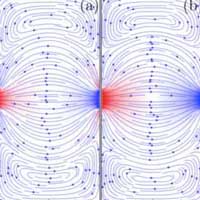 By studying how electrons in two-dimensional graphene can literally act like a liquid, researchers have paved the way for further research into a material that has the potential to enable future electronic computing devices that outpace silicon transistors.
By studying how electrons in two-dimensional graphene can literally act like a liquid, researchers have paved the way for further research into a material that has the potential to enable future electronic computing devices that outpace silicon transistors.
Thursday, April 25, 2019
Scientists propose new method for studying hydrodynamic behavior of electrons in graphene
 By studying how electrons in two-dimensional graphene can literally act like a liquid, researchers have paved the way for further research into a material that has the potential to enable future electronic computing devices that outpace silicon transistors.
By studying how electrons in two-dimensional graphene can literally act like a liquid, researchers have paved the way for further research into a material that has the potential to enable future electronic computing devices that outpace silicon transistors.
Crack propagation is asymmetric in polar materials
 Researchers report how, due to flexoelectricity, cracks in ferroelectrics (switchable polar materials) propagate more easily in the polar direction than in the opposite.
Researchers report how, due to flexoelectricity, cracks in ferroelectrics (switchable polar materials) propagate more easily in the polar direction than in the opposite.
Capturing the behavior of single-atom catalysts on the move
 Scientists precisely control where single-atom catalysts sit on their support structures, and show how changing their position affects their reactivity.
Scientists precisely control where single-atom catalysts sit on their support structures, and show how changing their position affects their reactivity.
Unprecedented insight into two-dimensional magnets using diamond quantum sensors
 For the first time, physicists have succeeded in measuring the magnetic properties of atomically thin van der Waals materials on the nanoscale.
For the first time, physicists have succeeded in measuring the magnetic properties of atomically thin van der Waals materials on the nanoscale.
New lens system for brighter, sharper diffraction images
 Researchers designed, implemented, and applied a new and improved focusing system for electron diffraction measurements.
Researchers designed, implemented, and applied a new and improved focusing system for electron diffraction measurements.
DNA as you?ve never seen it before, thanks to a new nanotechnology imaging method
 Nanochannel technology allows scientists to conduct an experiment never attempted before: map all the locations where DNA replication begins simultaneously on millions of single DNA fibers.
Nanochannel technology allows scientists to conduct an experiment never attempted before: map all the locations where DNA replication begins simultaneously on millions of single DNA fibers.
A close look at lithium batteries
 Fluorescence probe shows the distribution of active lithium species on lithium metal anodes.
Fluorescence probe shows the distribution of active lithium species on lithium metal anodes.
Nanostructures from hair to aid biomedical engineering
 Researchers have explored the hierarchical micro-/nanostructures from human hair and isolated these structures as a new kind of biomaterial.
Researchers have explored the hierarchical micro-/nanostructures from human hair and isolated these structures as a new kind of biomaterial.
Subscribe to:
Posts (Atom)
